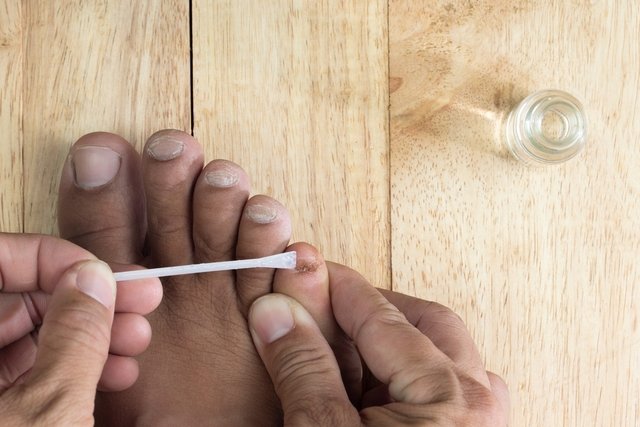Onychomycosis is a nail infection caused by fungi, which causes changes in the nails, such as increased thickness, yellowish or whitish color, detachment of the nail from the skin and the presence of a mass under the nail, for example, which can happen on both nails of hands and feet.
Onychomycosis, also called nail mycosis, can happen to anyone, being more common in people who have a more compromised immune system, have uncontrolled diabetes or have small recurring lesions on the nail. See more about nail fungus.
It is important that onychomycosis is identified and treated according to the dermatologist’s guidance, as this ensures the elimination of the fungus and relief of symptoms, and the use of ointments or nail polishes with antifungal properties is normally recommended.

Symptoms of onychomycose
The main symptoms indicative of onychomycosis are:
- Presence of a mass under the nail;
- Peeling;
- Increased nail thickness;
- Change in the color of the nail, which may become more whitish or yellowish;
- Detachment of the nail from the skin;
- Irregularities on the surface of the nail.
In the presence of signs and symptoms indicative of onychomycosis, it is recommended that a dermatologist be consulted so that the diagnosis can be made and the most appropriate treatment can be initiated.
How the diagnosis is made
The diagnosis of onychomycosis is made by the dermatologist initially by observing the characteristics of the nail, and the doctor also performs a scrape under the nail and/or the cutting of a part of the nail, which is sent to the laboratory for analysis. From laboratory analysis, it is possible to confirm the diagnosis of onychomycosis and identify the infectious agent responsible for the changes.
Make an appointment with the nearest dermatologist, using the tool below, so that a more detailed assessment of your nails can be carried out and, thus, a diagnosis can be made and the most appropriate treatment can be initiated:
Taking care of your health has never been easier!
Main causes
Onychomycosis is caused by fungi that need keratin to develop, as is the case with fungi Trichophyton rubrum, Microsporum spp. e Epidermophyton spp., and can also be caused by infection with the fungus Candida albicansbut less frequently.
Who is most at risk
Although onychomycosis can happen to anyone, some factors can increase the risk of this disease, such as:
- Uncontrolled diabetes;
- Problems with blood circulation;
- Family history of onychomycose;
- Small repetitive injuries to the nail;
- Frequent use of antibiotics;
- More compromised immune system.
Furthermore, if the person has already had onychomycosis and has not undergone complete treatment, it is possible that nail mycosis will recur repeatedly.
How the treatment is carried out
Treatment for onychomycosis must be indicated by a dermatologist and normally involves the use of ointments and/or nail polish with antifungal properties that must be applied directly to the nail. In some cases, the use of antifungal tablets, such as Itraconazole, may also be recommended.
Furthermore, depending on the characteristics of the nail and if treatment with the antifungal was not sufficient, the doctor may recommend surgical removal of the nail.
The treatment of onychomycosis tends to take a long time, lasting between 6 and 12 months depending on the speed of nail growth, and must be carried out according to the doctor’s instructions, even if the appearance of the nail has already improved. This is because, if treatment is interrupted, it is possible that the fungus will develop again and lead to onychomycosis again.

Sign up for our newsletter and stay up to date with exclusive news
that can transform your routine!
Warning: Undefined array key "title" in /home/storelat/public_html/wp-content/plugins/link-whisper-premium/templates/frontend/related-posts.php on line 12
Warning: Undefined array key "title_tag" in /home/storelat/public_html/wp-content/plugins/link-whisper-premium/templates/frontend/related-posts.php on line 13



